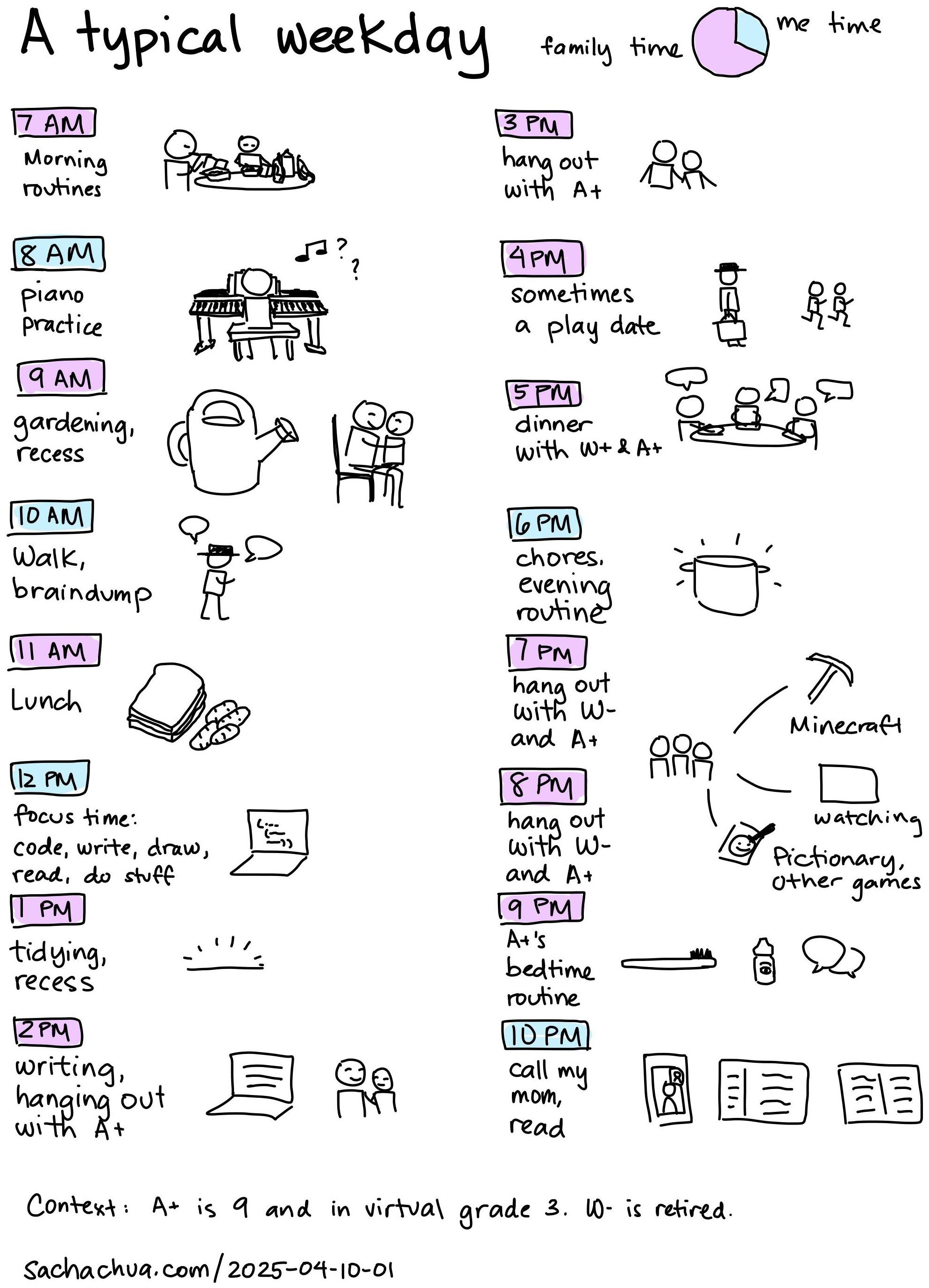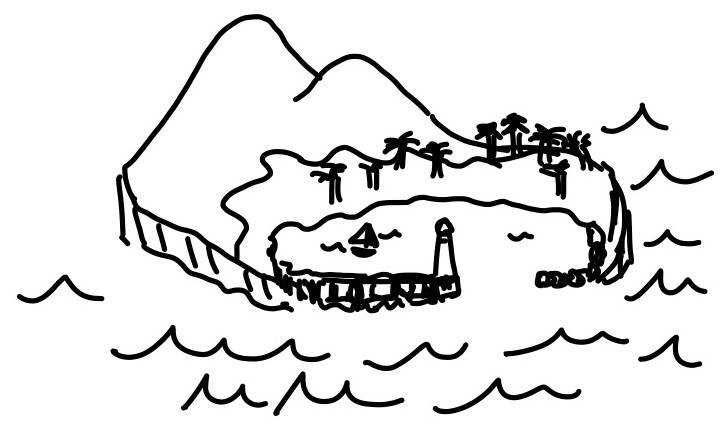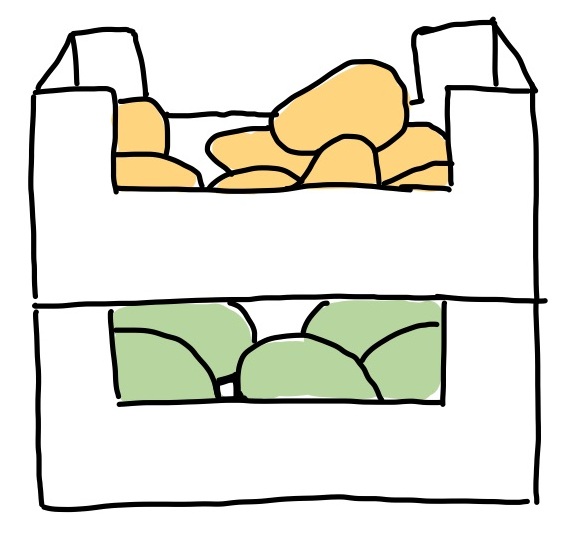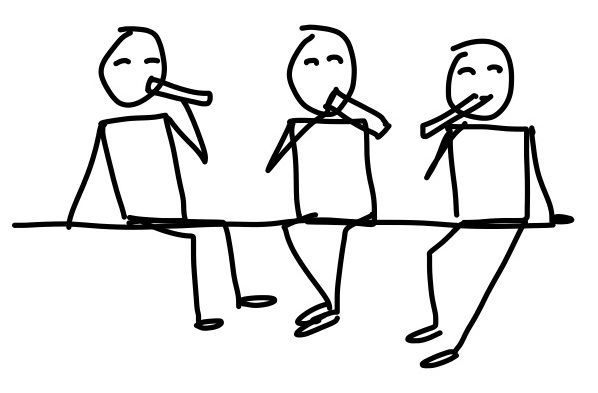IndieWeb April 2025: Renewal
| parentingThe IndieWeb writing prompt for April 2025 is renewal.
One of the things that I struggled with in the early days of parenting was the repetitive nature of my day. Every two- or three-hour cycle brought the same kinds of tasks: nursing, diapers, snuggles, sleep. Nothing could be crossed off a to-do list, nothing stayed done. Nothing built up towards tangible accomplishment, or at least, not for me.
There was change. A+ grew by leaps and bounds. One day she could only roll in one direction; the next she could roll every which way. My job was to take care of the foundation so that she could grow, to take care of all the repetitive tasks so that she could have all her firsts.
I remember thinking of the Zen kōan (sometimes attributed to Wu Li and sometimes elsewhere)
Before enlightenment; chop wood, carry water. After enlightenment; chop wood, carry water.
I don't claim to understand this fully yet, but I remember reasoning: these things had to be done. I signed up for them. Every day we still need to take care of ourselves and others. Some people make major lifestyle changes and forgo a high income in order to shift to a contemplative monastic life with the same kind of cycles. I can do it where I am. Maybe I can even treat them as moving meditations.
I recently finished reading The Courage to Be Disliked (Fumitake Koga and Ichiro Kishimi, 2013). Part of the book talks about seeing life as a dance:
Do not treat [life] as a line. Think of life as a series of dots. … Life is a series of moments, which one lives as if one were dancing, right now, around and around each passing instant. And when one happens to survey one's surroundings, one realizes, I guess I've made it this far. … With dance, it is the dancing itself that is the goal, and no one is concerned with arriving somewhere by doing it. Naturally, it may happen that one arrives somewhere as a result of having danced. Since one is dancing, one does not stay in the same place. But there is no destination.
Thanks to that tide of ever-renewing tasks that engulfed my day in the beginning and is only now beginning to calm, I've been slowly learning to let go of the desire for my own forward motion. I circle, and circle, and circle, and that's okay. I'm settling into the rhythm of our days, knowing that the beat will change over time. Sometimes I look up and I'm surprised at how far we've come.
… Aaaaaaand now I've got Dancing Through Life in my head. I definitely fall on the side of overthinking things more than swanning my way through life, but maybe I can learn more about relaxing into it.
Another comforting thought, this time from Meditations for Mortals (Oliver Burkeman, 2024), about how we don't have to do something extraordinary:
The first is that it simply need not follow, from our cosmic insignificance as individuals, that our actions don't matter. The idea that things only count if they count on the vastest scale is one more expression of our discomfort with finitude: accepting that they might count only transiently, or locally, requires us to face our limitations and our mortality. … Instead, you get to pour yourself into tasks that matter for no other reason than that nothing could be more enlivening, or more true to the situation in which you find yourself.
My life is still mostly full of the everyday rhythms, but that's okay. I don't change diapers any more, but there are still dishes to be done and snuggles to snuggle. When W- offers to do the dishes, I can say, "Thanks, I got it, I enjoy this part." In between, I'm slowly reclaiming time to do my own accumulation of progress. I'm even beginning to be able to write about life. Now I feel more at ease with the undirectedness of it, the little steps in my own dance.
Sometimes, of course, we stumble during the dance. Life with A+ isn't always smooth. Sometimes I (figuratively or literally) step on her foot. Sometimes we're out of sync. Sometimes we have a bad day. I'm learning that I don't have to feel too guilty about it, or try to fix it right away, or worry that I've permanently messed things up. Today, I can take the loss, the failure. Tomorrow is another day, another renewal. We can try something else then.
Besides, there's no point in trying to sort things out in the moment, when people are dysregulated. Better to take notes and figure out what to experiment with next time. There's so much to learn, and that's good.
This is probably something I'm going to need to remember when we head into adolescence, for at least as long as there are tomorrows I can share with A+.
That's the last aspect of renewal that I wanted to touch on: how parenting is helping me (re-)learn and examine all sorts of things. The skill of figuring things out together. The lessons that A+ is taking at school. The things I find fun. The hang-ups I've been carrying within me since my own childhood, and how I can untangle them. The parks and playgrounds and libraries in the city. The joy of sunshine. The way seeds sprout and perennials return in the garden. Everything is new all over again.
This is probably something I'll want to learn as much about during my kid-phase so that I can still enjoy it in my post-kid phase. I think the people who age the most gracefully are the ones who keep wondering, learning, and enjoying life, both familiar ground and the new opportunities that arise. I'd like to be one of those people. Renewal isn't just about going back to a previous state, like an axolotl regrowing a lost limb. Even with the rhythm of the same steps in this dance, I can find myself in new places, and I myself am changed.














